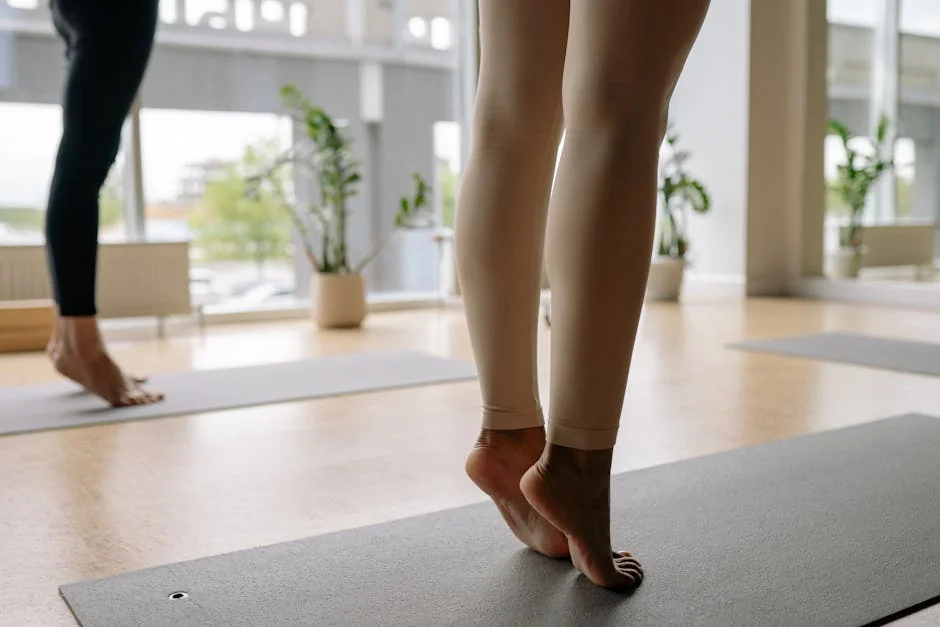Feeling like your brain is a browser with too many tabs open? In our non-stop world, it’s easy to operate on autopilot, swept away by a relentless stream of thoughts, notifications, and to-do lists. This constant mental chatter can leave you feeling stressed, disconnected, and utterly drained. But what if you could find an "off" switch for the chaos? This is where mindfulness meditation comes in—a simple yet profound practice of anchoring your awareness in the present moment without judgment. If you’re ready to cultivate more calm and clarity but aren't sure where to begin, you've come to the right place. This guide is packed with practical mindfulness meditation tips designed to demystify the process. We’ll walk you through everything from finding your posture and focusing your breath to overcoming common distractions, helping you build a sustainable practice that fits into your real life. Let's begin your journey.
What is Mindfulness Meditation and Why Practice It?
At its heart, mindfulness meditation is the practice of paying deliberate, non-judgmental attention to your present-moment experience. It’s not about emptying your mind or achieving a state of eternal bliss. Instead, it’s about training yourself to observe your thoughts, feelings, and bodily sensations as they arise, without getting tangled up in them.
Think of your mind as a clear blue sky. Your thoughts and feelings are like clouds—they drift in and out. Mindfulness teaches you to watch these clouds pass by without chasing them, resisting them, or getting lost in their stories. You learn to rest in the awareness of the sky itself. This shift in perspective is incredibly powerful, leading to a host of scientifically-backed benefits that address the very core of modern stress.
- Reduces Stress and Anxiety: By observing your worries without immediately reacting to them, you break the cycle of chronic stress. In fact, mindfulness meditation has been found to reduce stress and anxiety levels significantly. You learn to respond to life’s challenges from a place of calm rather than panic.
- Improves Focus and Concentration: In a world of endless distractions, mindfulness is a workout for your attention muscle. Regularly bringing your focus back to an anchor (like your breath) strengthens your ability to concentrate on tasks off the cushion.
- Enhances Emotional Regulation: Mindfulness creates a tiny space between a triggering event and your reaction. In that space, you gain the freedom to choose a more thoughtful response instead of being hijacked by your emotions.
- Increases Self-Awareness: The practice helps you tune into your body’s signals and recognize habitual thought patterns. This self-knowledge is the first step toward making positive changes in your life.
Essential Mindfulness Meditation Tips for Absolute Beginners
Starting a meditation practice can feel daunting, but it’s far simpler than most people imagine. The key is to let go of expectations and start with the basics. These foundational mindfulness meditation tips will set you up for success.
Start Small and Be Consistent Your ambition is admirable, but aiming for a 30-minute session on day one is a recipe for frustration. Instead, commit to just 3 to 5 minutes each day. A great way to start is with a quick mindfulness meditation to build the habit. Consistency is infinitely more important than duration. A short, daily practice builds a strong habit far more effectively than sporadic, long sessions.
Find a Comfortable Posture You don’t need to twist yourself into a lotus position. The goal is an alert yet relaxed posture.
- In a Chair: Sit with your feet flat on the floor, your back straight but not rigid, and your hands resting comfortably on your lap or knees.
- On a Cushion: If you’re on the floor, sit on a cushion or folded blanket to elevate your hips, allowing your knees to comfortably rest lower than your hips.
- Lying Down: You can also meditate lying down, though there’s a higher chance of falling asleep. If you choose this, lie on your back with your arms by your sides, palms facing up.
The most important thing is to keep your spine relatively straight to maintain alertness.
Use Your Breath as an Anchor Your breath is always with you, making it the perfect anchor for your attention. You don’t need to control or force it. Simply notice the physical sensations of breathing—the cool air entering your nostrils, the rise and fall of your chest or abdomen. When your mind wanders, which it will, gently guide your focus back to the feeling of your next breath.
Be Kind to Your Wandering Mind This is perhaps the most crucial of all mindfulness meditation tips. Your mind will wander. It’s not a sign of failure; it’s the entire point of the practice. Each time you notice your attention has drifted to a thought, a sound, or a bodily sensation, you’ve had a moment of mindfulness. Acknowledge the distraction with a gentle, internal label like “thinking” or “planning,” and without any self-criticism, guide your awareness back to your breath. This act of noticing and returning is the repetition that builds your mental strength.
Creating Your Ideal Mindfulness Meditation Environment
While you can practice mindfulness anywhere, creating a dedicated space at home can signal to your brain that it’s time to shift gears. You don’t need a special room—a small corner will do.
Choosing Your Space
Find a relatively quiet spot where you’re unlikely to be interrupted for the duration of your practice. This could be a corner of your bedroom, a spot in your living room, or even a walk-in closet. The consistency of using the same space helps condition your mind to settle down more quickly over time.
Setting the Ambiance
A little ambiance can go a long way in making your practice feel like a nurturing ritual.
- Lighting: Soft, natural light is ideal. Alternatively, you can use a dim lamp or light a candle (safely).
- Temperature: Ensure the room is at a comfortable temperature. Having a light blanket nearby can be helpful, as your body temperature may drop when you sit still.
- Comfort: Your cushion or chair is the centerpiece. Make sure it’s one you can sit on comfortably for your chosen time.
Tools to Enhance Your Practice
Technology can be a helpful aid, not just a distraction.
- Timer: Using a timer (on your phone in airplane mode or a dedicated meditation timer) frees you from clock-watching.
- Apps: Guided meditations from apps like Insight Timer, Headspace, or Calm can be excellent for beginners, providing structure and gentle instruction.
- Music or Sounds: Some people find soft, ambient sounds or binaural beats helpful for focusing, while others prefer silence. Experiment to see what works for you.
The Best Time of Day to Meditate
There is no single "best" time, but many practitioners find that meditating first thing in the morning sets a calm, intentional tone for the entire day. It gets your practice done before the day's demands pile up. Others prefer to meditate in the evening to decompress and process the day's events. The best time is the one you can consistently stick with.
Mastering the Core Technique: A Step-by-Step Guide
Ready to put these mindfulness meditation tips into action? Here is a simple, step-by-step guide for a 10-minute seated practice.
Step 1: Settle Into Your Space Set your timer for 10 minutes. Take your chosen posture, either on a chair or cushion. Gently close your eyes or lower your gaze. Take two or three deep, intentional breaths to signal the start of your practice.
Step 2: Connect with Your Body Bring your awareness to the physical sensations of your body. Notice the points of contact—your feet on the floor, your sit bones on the cushion or chair, your hands resting on your lap. Scan your body from head to toe, simply noticing any sensations without trying to change them.
Step 3: Find Your Anchor in the Breath Now, gently direct your attention to your breath. Choose a primary anchor point—the sensation of air moving in and out of your nostrils, or the rise and fall of your chest or abdomen. There is no need to control the breath; just observe it as it is.
Step 4: Gently Count the Breaths To help maintain focus, try silently counting your breaths. Inhale... exhale... "one." Inhale... exhale... "two." Continue this up to ten, and then start back at one. If you lose count, simply begin again at one without judgment. This counting technique is a powerful tool to steady a busy mind.
Step 5: Work with Wandering Thoughts Inevitably, your mind will wander away from the breath. You might start thinking about work, planning dinner, or replaying a conversation. The moment you realize your mind has wandered, gently acknowledge it. You can silently say to yourself, “thinking,” or “wandering.” Then, with a sense of kindness, return your attention to the physical sensation of your next breath. This is the core of the practice.
Step 6: Gently Conclude Your Session When your timer sounds, don't jump up immediately. Allow your awareness to expand back to the feeling of your entire body sitting in the space. Notice any sounds in the environment. Gently wiggle your fingers and toes. Slowly open your eyes. Take a moment to transition before you move on with your day, carrying a little of that mindful awareness with you.
Overcoming Common Meditation Challenges
Every meditator faces hurdles. Anticipating them can help you navigate them with grace.
Falling Asleep If you frequently doze off, try meditating at a different time of day, perhaps when you are more alert. You can also open your eyes slightly or meditate in a more upright, alert posture. Ensure you’re getting enough sleep at night.
Physical Discomfort Some discomfort is normal as you get used to sitting still. Adjust your posture slightly if you need to. For persistent pain, try using more supportive cushions or switch to a chair. The goal is comfort, not endurance.
Feeling Bored or Impatient Boredom is just another thought pattern to observe. When it arises, see if you can bring a fresh curiosity to your experience. What does this specific breath feel like? Can you notice the subtle beginning, middle, and end of each inhalation and exhalation? Boredom often masks a restless mind.
Dealing with Strong Emotions Sometimes, sitting in stillness can bring up strong emotions like sadness or anger. Instead of suppressing them, try to approach them with curiosity. Where do you feel this emotion in your body? Is it a tightness, a heat, a heaviness? Observe these physical sensations as you would observe your breath, allowing them to be present without needing them to change.
Integrating Mindfulness into Your Daily Life
The true power of mindfulness is realized when you bring it off the cushion and into your everyday activities. These are often called "informal" practices.
- Mindful Eating: For one meal a day, eat without distractions. Notice the colors, smells, textures, and flavors of your food. Chew slowly and savor each bite.
- Mindful Walking: As you walk, feel the sensations in your feet and legs. Notice the air on your skin and the sights around you. When your mind wanders, gently bring it back to the physical experience of walking.
- Mindful Listening: When in conversation, try to listen fully without planning what you’re going to say next. Give the other person your complete attention.
- The STOP Method: Whenever you feel stressed, pause and:
- Stop what you are doing.
- Take a breath.
- Observe your thoughts, feelings, and bodily sensations.
- Proceed with more awareness.
Building a Lasting Mindfulness Habit
The journey of mindfulness is a marathon, not a sprint. Building a lasting habit requires patience and self-compassion.
Track Your Progress You might not feel different immediately, but subtle changes are happening. Keeping a simple journal where you note down a word or two about your practice (e.g., "calm," "restless," "sleepy") can help you see your progress over time.
Find a Community Practicing with others can provide motivation and support. Look for a local meditation group or an online community. If you feel you need more structured guidance, consider learning from a mindfulness meditation teacher. Sharing experiences can be incredibly validating.
Be Patient and Compassionate with Yourself Some days your mind will be calm; other days it will feel like a whirlwind. This is normal. The practice is about showing up for yourself, regardless of the internal weather. Let go of the need for a "perfect" session. Every moment you spend observing your mind with kindness is a moment of successful practicing mindfulness and meditation. This journey is about returning, again and again, to the present moment—your true home.
In conclusion, the journey of mindfulness meditation is one of gentle, consistent practice. By establishing a regular routine, even for just a few minutes each day, and focusing on the foundational techniques of anchoring your attention to the breath and observing thoughts without judgment, you can cultivate a profound sense of presence and calm. Remember that the goal is not to empty the mind, but to become a more compassionate and aware observer of its contents. The challenges of restlessness or frustration are not signs of failure, but integral parts of the process. We encourage you to revisit these tips whenever you need guidance and to approach your practice with patience and self-kindness. This path offers a powerful, accessible tool for navigating life's complexities with greater clarity and resilience. Begin today, and trust that each mindful moment is a step toward a more centered and peaceful existence.



